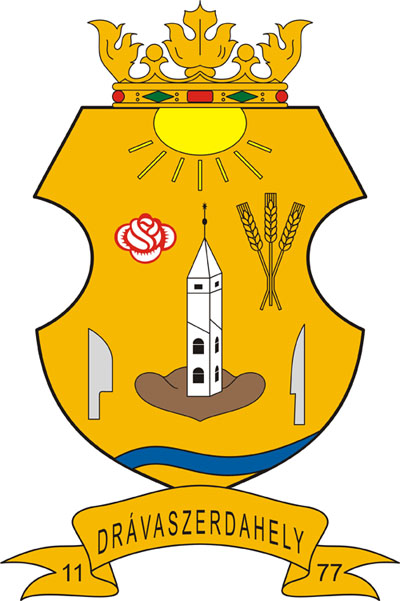
(Baranya megye)
A pajzs a címertanban tárcsapajzs, szélei fekete vonallal vannak kiemelve. Címerpajzs alatt, a pajzs alsó, csücskös részén áthaladva lobogó, aranyszínű címerszalag, benne a következő szöveg: 11 DRÁVASZERDAHELY 77. Vagyis a címerszalag középső részén a település neve, két szélén, egymástól elválasztva az évszám, amikor a falu nevét először említette írott forrás. Tárcsapajzs tetején aranyszínű korona, benne két kör alakú, egy téglalap alakú sarkain lekerekített piros színű, valamint két négyszög alakú, zöld színű drágakő.
Korona jelzi, hogy a település királyi falu, már Árpádházi királyok alatt létezett. Tárcsapajzs sárga színű, benne alsó részén a kék színű folyó, amely a közeli Drávát, a falu nevének előtagját jellépezi. Feljebb baloldalon a heraldikában stilizált, csúcsával felfelé állított ekevas, jobbra a szintén stilizált és csúcsával felfelé állított csoroszlya. Mindkettő szimbolizálja a mezőgazdaságot, a földművelést, amellyel az itt élők foglalkoztak. Stilizált eke és csoroszlya között középen a barna színű föld, amit a helyiek megműveltek. Föld közepén a fehér színű református templom fekete ablakokkal, amelynek léte évszázadok óta uralja a település képét. Templom csúcsától balra piros színű kontúrokkal díszrózsa, amely látható Drávaszerdahely első, feudáliskori címerpecsétjében is. Templom csúcsától jobbra háromágú, szárain alul összekötött, sárga, megérett gabonakéve, amely jelenti egyben a földművelés helyi fontosságát és a kenyeret, az életet, amiért az itt élt emberek dolgoztak. Tárcsapajzs felső részén a világossárga, ragyogó nap, amely érleli a gabonát, élteti a virágot, szimbolizálja a jövőt, a reménységet.
(The County of Baranya)
Spade shield erect, contoured sable, its base is curved to a point. Below the shield, intersecting the base a ribbon or with the inscription 11 DRÁVASZERDAHELY 77. It means that the middle section of the ribbon bears the name of the settlement, while on the left and on the right from it –separated by the settlement’s name – the date is inscribed, the year, when the settlement’s name was first mentioned in writing. Spade shield is topped with a crown or, in which two circular and two square-shaped gems are borne, gules and vert.
The motif of the crown is an emblem of the fact that the settlement already existed during the reign of the kings of the Árpád dynasty, and also the fact that it was a royal possession. Shield is tinctured or, in base a wavy line azure, which symbolises the nearby Dráva river. The name of the river is also the anterior constituent of the settlement’s name. In sinister chief the stylised depiction of a ploughshare and a coulter, the two tools are pointing upwards. Both motives are references to agriculture, the main occupation of the inhabitants of Drávaszerdahely. Between the stylised depictions of the ploughshare and the coulter the ground proper (brown) is depicted. It symbolises the soil, the main source of living of the local people. In the centre the building of the Calvinist church, argent is borne, its windows are tinctured sable. The church has represented the most typical building of the village for centuries. From the spire, to the sinister a heraldic rose is borne, contoured gules. The same charge appeared in the historical printed seal of Drávaszerdahely, which was created in the period of feudalism. To the dexter a three-part, ripe sheaf of wheat, or, a charge, which symbolises the significance of agriculture, as well as the bread and the livelihood of the local inhabitants. In chief the motif of the sun rayonnant, or, which, by ripening the wheat and sustaining life symbolises hope and future.